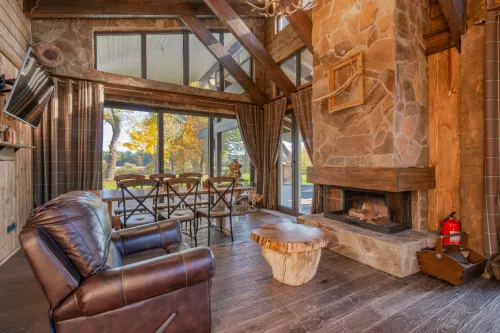Architecture is not just the art and science of designing buildings; it's a reflection of our culture, technology, and aspirations. Over centuries, various architectural styles have emerged, each with its own set of characteristics, ideologies, and historical contexts.
From the grandiose pyramids of ancient Egypt to the sleek, glass skyscrapers that define our modern skyline, the evolution of architectural styles tells the story of human civilization itself.
In exploring the vast world of architectural styles, we not only appreciate the beauty and functionality of buildings but also gain insights into the cultural and historical contexts that gave rise to these diverse forms of expression.
Whether you're an aspiring architect, a history enthusiast, or simply someone who admires the skyline, understanding architectural styles enriches your perspective on the world around you.
The Four Pillars of Architecture
When we learn about architecture, four main types often come to the forefront: Classical, Modern, Gothic, and Baroque.
Classical Architecture
Rooted in ancient Greek and Roman civilizations, this style is renowned for its emphasis on symmetry, proportion, and the use of columns. The Parthenon in Athens is a quintessential example.
Modern Architecture
Emerging in the late 19th and early 20th centuries, Modernism was a reaction against ornate styles. It champions functionality, minimalism, and the use of new materials like steel and concrete. The Fallingwater house by Frank Lloyd Wright beautifully embodies this style.
Gothic Architecture
Originating in 12th-century France, Gothic architecture is best known for its verticality, pointed arches, and elaborate detailing. The Notre-Dame Cathedral in Paris stands as a stunning testament to this style.
Baroque Architecture
With its origins in 17th-century Italy, Baroque architecture is characterized by dramatic use of light and shadow, bold ornamentation, and a sense of movement within the structure. The Versailles Palace is a prime example of this extravagant style.
The Trendsetter of Today: Contemporary Architecture
As we move through the 21st century, Contemporary Architecture takes center stage, reflecting a mix of various styles, with an emphasis on sustainability, technological integration, and innovative use of space. This style is not tied to any specific set of rules but is defined by its creativity and adaptability to the needs and values of modern society.
Contemporary Architectural Design
Falling under the umbrella of modern architectural styles, contemporary residences often adopt unconventional, asymmetrical layouts adhering to minimalist design philosophies. Such designs might feature, for example, an L-shaped configuration that cleverly contrasts the garage area with the living quarters.
Characterized by their sleek, unadorned lines and a preference for geometric forms with flat roofing, these contemporary structures offer a wide array of design options. Moving beyond traditional materials like wood and plaster, these homes frequently incorporate elements of steel, glass, and concrete.
Timelessness in Stone and Space: Classical and Modern
Timeless Architecture denotes edifices and constructions that maintain their aesthetic allure, practicality, and significance across the ages. Such architectural works are typically marked by their straightforwardness, grace, and flexibility, surpassing the fleeting nature of trends and styles.
When we talk about timeless architecture, the Classical and Modern styles often come to mind. These styles have transcended their eras to influence generations of architects and continue to resonate with people worldwide.
Classical Architecture
Rooted in the ancient traditions of Greek and Roman civilizations, this type of architecture has long been celebrated for its harmonious proportions, symmetry, and adherence to a set of defined principles and orders. This architectural style is characterized by the use of iconic columns, pediments, and entablatures, each serving a distinct functional and aesthetic purpose.
The innate appeal of classical architecture lies in its representation of an idealized order and beauty. It resonates with our deep-seated appreciation for symmetry and proportion, qualities that are often associated with nature and the human form itself.
Modern Architecture
In stark contrast to the ornamental and historical references of previous styles, modern architecture emerged in the 20th century as a movement that embraced simplicity, clean lines, and a focus on function.
This style represented a deliberate break from the past, emphasizing new construction technologies and materials. The appeal of modern architecture lies in its straightforwardness and its ability to respond to the changing needs and technologies of the time. Its simplicity and functionality resonate with those who value practicality and a departure from excessive ornamentation.
A Tapestry of Architectural History
Understanding architectural styles is akin to unraveling the history of human civilization. Each style is a chapter in the story, marked by cultural shifts, technological advancements, and artistic movements.
Renaissance Architecture
Renaissance architecture, which flourished between the 14th and early 17th centuries, marked a revival of the classical architecture of ancient Greece and Rome. This period was characterized by a renewed interest in the humanities, which influenced architectural design principles significantly.
Key Features:
- Harmony and Proportion: Architects of the Renaissance era, like Filippo Brunelleschi and Leon Battista Alberti, emphasized mathematical precision, harmonic proportions, and a human-centered scale in their designs.
- Columns and Pilasters: Renaissance buildings often feature classical columns and pilasters, drawing directly from ancient Greek and Roman architecture.
- Domes and Arches: The use of domes and arches became prominent during this period, with the dome of Florence Cathedral by Brunelleschi standing as a quintessential example.
- Significance: Renaissance architecture represents a bridge between the ancient world and the modern, laying the groundwork for future architectural innovations. Its emphasis on proportion, balance, and integration of the individual into the space reflects a deep engagement with humanist principles.
Victorian Architecture
Victorian architecture refers to the diverse architectural styles that emerged during Queen Victoria's reign from 1837 to 1901. This era is known for its eclectic approach, incorporating a wide range of historical styles and ornate details.
Key Features:
- Eclecticism: Victorian architecture is characterized by a mix of Gothic Revival, Italianate, Romanesque Revival, and other styles, often within a single structure.
- Ornamentation: Buildings from this period frequently feature elaborate decorations, including patterned brickwork, carved woodwork, and intricate tile designs.
- Innovation: The Victorian era saw significant advancements in construction technologies, such as the use of cast iron and steel, leading to new building techniques and forms.
- Significance: Victorian architecture reflects the complexities and contradictions of the Industrial Revolution, embodying the tension between traditional craftsmanship and industrial innovation. Its rich ornamentation and stylistic diversity speak to a society in the midst of profound change.
Art Deco
Art Deco, a prominent architectural style that emerged in the 1920s and 1930s, is celebrated for its modernity, bold geometric patterns, and luxurious details. Originating in France, it quickly spread worldwide, influencing the design of buildings, furniture, jewelry, and even everyday objects.
Key Features:
- Geometric Forms: Art Deco architecture is known for its use of stark geometric shapes, including zigzags, chevrons, and sunburst motifs.
- Exotic and Luxurious Materials: The style often incorporates rare and expensive materials such as ivory, jade, and silk, reflecting a fascination with luxury and craftsmanship.
- Streamlining: In the later stages of Art Deco, designs became more streamlined, influenced by aerodynamic principles and the emerging technologies of aviation and automotive design.
- Significance: Art Deco represented the epitome of luxury and sophistication during its heyday, embodying the exuberance and optimism of the Roaring Twenties and the technological advances of the early 20th century. Its influence is still seen in contemporary design, highlighting its enduring appeal.
Transitional Architecture
Transitional architecture is a harmonious fusion of classic and contemporary elements, creating spaces that balance traditional elegance with modern efficiency. This style skillfully melds the warmth and detail of traditional designs with the clean lines and innovative materials of modern architecture.
Key Features:
- Material Fusion: Incorporates modern materials such as industrial metals with traditional design forms.
- Open Floor Plans: Offers spacious, open living areas that enhance the flow and functionality of the space.
- Ornamental Warmth: Includes decorative elements absent in stark contemporary designs, adding a layer of comfort and visual interest.
- Sleek Yet Traditional: Maintains a polished look that is more refined than many classic designs, often featuring large windows, glass doors, and detailed crown molding.
- Essence: Transitional architecture is about finding the perfect balance, offering a home that is both inviting and forward-looking without being overly experimental.
Bauhaus Architecture
Emerging from the industrial revolution's innovations, Bauhaus architecture embodies the principles of simplicity, functionality, and the integration of industrial materials into design. This style aligns with contemporary minimalist trends, prioritizing practicality and clarity in architectural expression.
Key Features:
- Functional Simplicity: Focuses on the practical use of space, stripping away unnecessary ornamentation.
- Industrial Materials: Embraces the use of modern materials like steel, glass, and concrete, reflecting the industrial era's influence.
- Geometric Clarity: Features clean lines and geometric shapes, often resulting in asymmetrical but balanced compositions.
- Innovative Transparency: Utilizes glass curtain walls to create a sense of openness and fluidity between indoor and outdoor spaces.
- Essence: Bauhaus architecture is a celebration of modernity and efficiency, utilizing industrial advancements to create functional, yet aesthetically pleasing, minimalist designs.
People also ask
How does architecture impact our daily lives?
Architecture shapes our environment, influences our mood, and reflects our society's values and history. From the homes we live in to the public buildings we interact with, architecture is integral to our daily experiences.
Can architectural styles blend together?
Yes, many contemporary buildings incorporate elements from multiple styles, creating unique, hybrid structures that reflect a blend of influences.
How are new architectural styles born?
New styles often emerge as a response to cultural shifts, technological advancements, and the evolving needs of society. They can also arise from individual architects' innovations and the influence of other art forms.

 Marcio Vasconcelos
Marcio Vasconcelos





